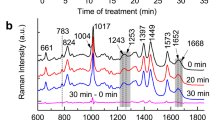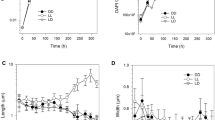Summary
The ultrastructure of T. antarctica var. antarctica vegetative and resting stages are compared using light and transmission electron microscopy. Resting spores contain noticeably more lipid reserves than do vegetative cells. Numerous mitochondria and generally fewer numbers of other organelles are eliminated from spores into an abortive daughter cell when the spore formation division sequence is terminated. The remaining spore contents are a compact arrangement of organelles with lipid bodies predominating. These two stages are thus ultrastructurally distinct, and differences in their chemical composition can be manifested as cytological modifications.
Similar content being viewed by others
References
Anderson OR (1975) The ultrastructure and cytochemistry of resting cell formation in Amphora coffeaeformis (Bacillariophyceae). J Phycol 11:272–281
Anderson OR (1976) Respiration and photosynthesis during resting cell formation in Amphora coffeaeformis (Ag.) Kütz. Limnol Oceanogr 21:452–456
Badour SS, Gergis MS (1965) Cell division and fat accumulation in Nitzschia sp. grown in continuously illuminated mass culture. Arch Mikrobiol 51:94–102
Cassie V, Dempsey GP (1980) A new freshwater species of Thalassiosira from some small oxidation ponds in New Zealand, and its ultrastructure. Bacillaria 3:273–292
Comber TC (1896) On the occurrence of endocysts in the genus Thalassiosira. J R Microsc Soc 85:119–134
Cooley CA, Lucas JA, Schardein JL (1972) A modified hematoxylinsafranin stain for 0.5–2 μ sections. Stain Technol 47:44–46
Darley WM (1977) Biochemical composition. In: Werner D (ed) The biology of the diatoms. University of California Press, Berkeley Calif, pp 198–223
Davis CO, Hollibaugh JT, Seibert DLR, Thomas WH, Harrison PJ (1980) Formation of resting spores by Leptocylindrus danicus (Bacillariophyceae) in a controlled experimental ecosystem. J Phycol 16:296–302
Doucette GJ (1982) Variability in patterns of resting spore formation in the diatom Thalassiosira antarctica. Eos 63:47
Doucette GJ, Burghardt RC, Fryxell GA (1984) The genus Thalassiosira: protoplast ultrastructure of the bipolar diatom Thalassiosira antarctica Comber. Can J Bot 62:1513–1522
Doucette GJ, Fryxell GA (1983) Thalassiosira antarctica: vegetative and resting stage chemical composition of an ice-related marine diatom. Mar Biol 78:1–6
Drebes G (1969) Stephanopyxis turris (Centrales) — Ungeschlechtliche Fortpflanzung durch Dauersporen. Film E 1342 des Inst Wiss Film, Göttingen (FRG)
Durbin E (1978) Aspects of the biology of resting spores of Thalassiosira nordenskioeldii and Detonula confervacea. Mar Biol 45:31–37
French FW, Hargraves PE (1980) Physiological characteristics of plankton diatom resting spores. Mar Biol Lett 1:185–195
Fryxell GA, Doucette GJ, Hubbard GF (1981) The genus Thalassiosira: the bipolar diatom T. antarctica Comber. Bot Mar 24:321–335
Garrison DL (1981) Monterey Bay phytoplankton. 2. Resting spore cycles in coastal diatom populations. J Plankton Res 3:137–156
Guillard RRL, Ryther JH (1962) Studies of marine planktonic diatoms. 1. Cyclotella nana Hustedt, and Detonula confervacea (Cleve) Gran. Can J Microbiol 8:229–239
Hargraves PE, French FW (1983) Diatom resting spores: significance and strategies. In: Fryxell GA (ed) Survival strategies of the algae. Cambridge University Press, New York, pp 49–68
Hasle GR, Heimdal BR (1968) Morphology and distribution of the marine centric diatom Thalassiosira antarctica Comber. J R Microsc Soc 88:357–369
Herth W (1979) The site of β-chitin fibril formation in centric diatoms. 2. The chitin-forming cytoplasmic structures. J Ultrastruct Res 68:16–27
Herth W, Barthlott W (1979) The site of β-chitin fibril formation in centric diatoms. 1. Pores and fibril formation. J Ultrastruct Res 68:6–15
Hoban MA, Fryxell GA, Buck KR (1980) Biddulphioid diatoms: resting spores in antarctic Eucampia and Odontella. J Phycol 16:591–602
Hollibaugh JT, Seibert DLR, Thomas W (1981) Observations on the survival and germination of resting spores of three Chaetoceros (Bacillariophyceae) species. J Phycol 17:1–9
Palmisano AC, Sullivan CW (1982) Physiology of sea ice diatoms. 1. Response of three polar diatoms to a simulated summer-winter transition. J Phycol 18:489–498
Shifrin NS, Chisholm SW (1981) Phytoplankton lipids: interspecific differences and effects of nitrate, silicate and light/dark cycles. J Phycol 17:374–384
Smith AE, Morris I (1980) Pathways of carbon assimilation in phytoplankton from the Antarctic Ocean. Limnol Oceanogr 25:865–872
Tzitsikas H, Rdzok EJ, Vatter AE (1962) Staining residual lipids in ultrathin sections of tissues embedded in polyester resin. Stain Technol 37:299–301
Author information
Authors and Affiliations
Rights and permissions
About this article
Cite this article
Doucette, G.J., Fryxell, G.A. Thalassiosira antarctica (Bacillariophyceae): Vegetative and resting stage ultrastructure of an ice-related marine diatom. Polar Biol 4, 107–112 (1985). https://doi.org/10.1007/BF00442908
Received:
Accepted:
Issue Date:
DOI: https://doi.org/10.1007/BF00442908




